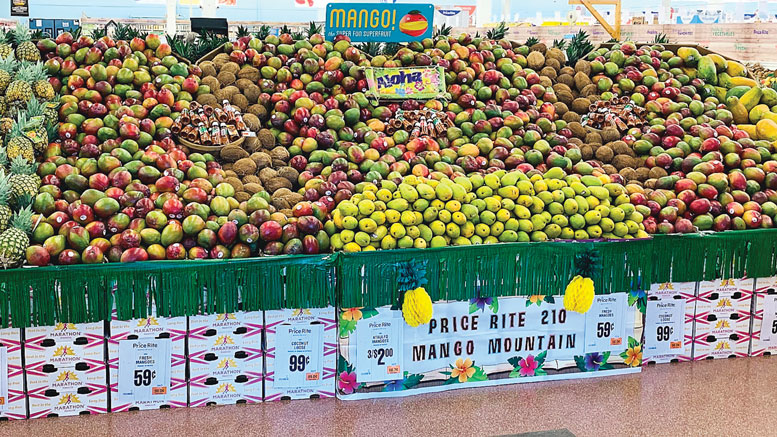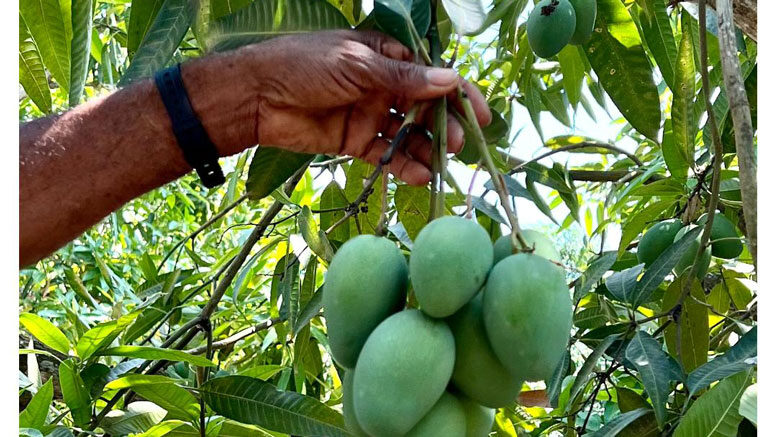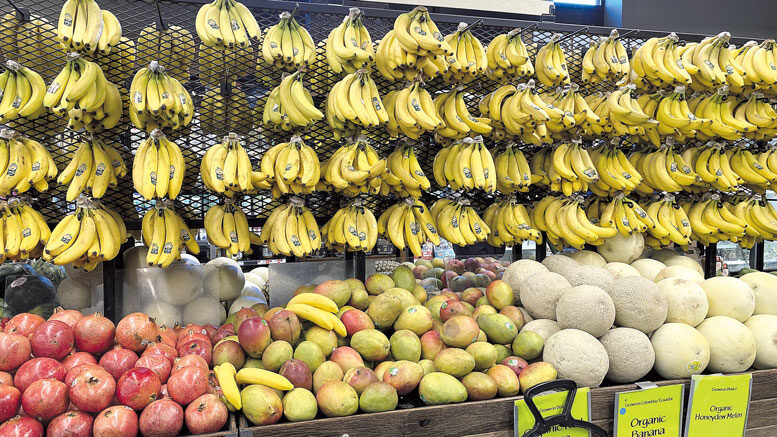BRINGING MANGOS TO THE CONSUMER
June 12, 2023 | 8 min to read
The Sweet Sugar Mango, grown in the Magdalena region of Colombia, has debuted in the U.S. market, offering a unique, sweet flavor and enticing aroma. Nicholas Bernal from Seasons Farm Fresh Inc. anticipates it will transform supermarket produce sections. While the mango's season lasts until July, retailers report strong pre-orders. With U.S. mango consumption steadily increasing, the fruit is evolving from exotic to a regular staple, driven by growing demand, especially among younger consumers and Hispanic communities.

A new supersweet mango reaches the U.S. market.
Originally printed in the May 2023 issue of Produce Business.
As the U.S. mango market matures, Sweet Sugar Mango has entered the mango lineup.
Grown in the Magdalena region along the Caribbean coast of Colombia, this delectable small mango is one of its few native products. Cradle one in the palm of your hand, whiff the fruity fragrance, bite past the thin skin into the juicy, smooth, red-and-yellow sweetness, and experience the new Sweet Sugar Mango, available in the U.S. since mid-April.
Nicholas Bernal, CEO of Seasons Farm Fresh Inc., Miami, predicts the Sweet Sugar Mangos “are going to revolutionize the fruit section of supermarkets across the U.S. With an unforgettable aroma and unique sweet flavor, these mangos are the perfect addition to any lunchbox or meal, giving the right size bite without being too filling.”
Harvested from small family farms, most of the fruit is exported within 24 hours of the harvest. Upon arrival to the U.S., it is irradiated for phytosanitary protection, and to preserve flavor and enhances shelf life. Seasons Farm Fresh, Inc., the importer, distributor and licensee in the U.S. market, packs the mangos in 2 kg boxes, with 15 to 22 per box.
Depending on the weather, Bernal expects major retailers and foodservice venues to have mangos from that first April shipment until July and August.
Grower, packer, importer and exporter Goldenberry Farms, Miami, and Medellin, Colombia, has sold and branded its Sugar Mango successfully in Canada and Europe for several years.

“We are thrilled to be entering the U.S. market after several seasons of planning and preparation,” says Juliana Lopez, Goldenberry Farms’ business relationship manager. “The retailer and market demand has been even stronger than we expected, with supply nearly sold out with retailer pre-orders. A limited supply is still available with the season continuing through July.”
Retailers can access point-of-sale tools, digital displays, artwork for print, social media and high-resolution images where they can insert their own logos. Also, retailers can opt to sell by weight instead of by count.
Sugar Mango and Sweet Sugar Mango, both trademarked, are used interchangeably. With either name, the Brix level is nearly 22.
FLAVOR, VERSATILITY DRIVES SALES
Mangos reportedly first appeared more than 5,000 years ago in India. Today, India celebrates mangos as a symbol of love.
What’s to love about mangos?
First, thank the Spanish explorers in the 1600s who brought mangos to South America and Mexico. Since mangos are a tropical fruit, enterprising importers and distributors condition, package and ship multiple varieties of mangos to U.S. markets, which makes them available all year. Almost all — 98% — of mangos consumed in the U.S. are imported. Mexico accounts for about 65%, followed by Peru, Ecuador, Brazil, Guatemala and Haiti.
The National Mango Board (NMB) reports that anytime a consumer goes to a U.S. supermarket, at least one of these six popular varieties is likely to be available: Tommy Atkins: oval, red-blushed, firm, golden fleshed, mildly sweet; Honey (also known as Ataulfo): yellow, smooth, firm, fiber-less, sweet and creamy; Kent: dark green with red blush, oval, juicy, tender, few fibers, peachy, sweet and rich; Keitt: green with pink blush, oval, citrusy, firm, juicy, sweet and tangy; Haden: red with green and yellow overtones and white dots, round or oval, firm with fine fibers; Francis: oblong or S-shaped, yellow with green overtones, soft, juicy, fibrous, rich, spicy and sweet.
Diego Vargas, senior purchasing manager at J&C Topicals in Miami, describes common preferences. “Most popular are Tommy and Kent because of their color. Also, Kent has less fiber. Ataulfo, has the most, but it and Kesar are sweeter. If you want sweet, then buy yellow mangos, which are sweeter than the larger Tommy and Kent varieties.”
GROWTH WILL CONTINUE
Globally, mangos are the No. 1 fruit. Not long ago, they were considered exotic. “Now, they are a staple in the produce category; you just can’t beat them,” observes Tom Argyros, sales manager at RCF Produce Distributors in Nogales, AZ. “Since 1995, my sales have tripled.”
Mango consumption has been increasing. Statista charts show that U.S. per capita consumption of only 1.75 pounds in 2000 jumped to 3.66 pounds in 2021. NMB reports 2022 mango per capita availability was 3.76 pounds per person.
Tom Hall, sales manager of Freska Produce International LLC, Oxnard, CA, says there is opportunity for mangos “to move up to be really an everyday item, and they should continue to grow at a fast pace as people become more familiar with the taste. I can’t see it slowing down.”
Ronnie Cohen, principal at Vision Import Group LLC, in Hackensack, NJ, agrees mangos are poised for continued growth. “In the USA, mangos are evolving as a commodity, and are about 10 years behind the success of avocados. There is exponential growth for the next generations of consumers.”
Vargas points to some prime demographic movers. “Asians and Hispanics are moving the needle on the mango. They influence other groups toward mangos, as well. In addition, the younger generation’s zeal for mangos in smoothies boosts sales.”

PRODUCE BUSINESS PHOTO
Vargas says consumers in the highly populated cities, including New York and those on the West Coast, especially enjoy mangos. “In the center part of the U.S.— Montana, North Dakota, Iowa, Missouri — mangos are not as popular as they could be. They regard mangos as exotic fruit.”
Argyros says the key to a great eating experience is ripeness. “We are getting better at offering riper fruit — faster deliveries from packinghouses and shipping the harvest.” If unripe at home, the National Mango Board instructs consumers to speed ripening by placing the mangos in a paper bag. The board also has a ripening program for retailers.
Cohen adds, “Europe has had great success with ‘Ripe and Ready’ for many years. Sales increase and consumers are willing to pay more money when they can be assured of a great eating experience.”
‘Ripe and Ready to Eat Mango’ is a best handling practice developed and offered by the NMB for retailers and the mango industry in general, explains NMB executive director Manuel Michel. “Availability of ripened or conditioned mangos at U.S. retail is more widely available than ever before.”
KEEP AN EYE ON ORGANIC DEMAND
There is demand for organic, says Vargas, “but they are not growing as fast as regular mangos, in my opinion. Consumers are not as concerned about mangos in their diet as meat, for example.”
Freska’s Organic Dried Mango maintains the sweetness, juiciness and nutrition of the fruit. Hall adds, “It has seen positive success and took off during the pandemic. It also enables us to use all the fruit.”
PLAN PROMOTIONS
How to increase sales?
“It’s amazing,” Argyros says. “Mangos can be put anywhere in the produce department. They don’t cannibalize another fruit, either. If you buy a Red Delicious, Granny Smith or Gala, etc., sales of other apples will drop — same thing with peaches, and other stone fruit. This is because mangos are so variable. They are the Swiss Army knives of the produce department.”
He says there will be a good opportunity to promote as summer progresses. “Be ready.”
To stimulate demand, Cohen advises retailers educate consumers, “and deliver great experiences of mangos for repeat business.”
Chris Ciruli, chief operating officer, Ciruli Brothers, Nogales, AZ, agrees spring is a great time to promote mangos. “The Fourth of July holiday is also a big mover for avocados and mangos. May, June and beyond should produce double-digit increases. Consumption is growing. I don’t see any slacking off soon.”
ADAPT TO FUTURE SALES
Technology can bring higher online sales with more interactive elements such as video, enhanced browsing and greater ways toward personalizing customer choices.
“Shopping online can be convenient and timesaving, but looking, feeling, touching and smelling produce cannot be replaced,” Cohen says. “A shopper is more likely to be charmed into buying on impulse in person than from their computer or smartphone. Nothing can replace a local produce manager knowing their local consumers.”
A QR code sends shoppers to the NMB’s website where they can access instant information. Greg Golden, partner and sales manager, Amazon Produce Network LLC, Vineland, NJ, explains how the QR code works for customers in a store or at home. “The QR code lands on a page provided by the National Mango Board that gives some basic useful information to the consumer, such as the characteristic that make each mango variety unique. The page also provides how-to-cut videos, nutritional information and lots of great recipes.”
Tammy Wiard, NMB’s senior retail marketing manager, says the NMB also offers a wide selection of videos and social media assets for retailers to engage their consumers and followers on their own social channels. “Short run and long version videos are available to use in-store and online to tell the mango story.”
Technological advances in agriculture can help provide increased volumes and fresher products. Noticing a few problems, Argyros says early season this year has been “hit and miss. It hasn’t been consistent.”
Cohen notes mangos are challenging, like any other commodity. “They can have growing challenges, such as weather, logistics and transit times. Post-harvest cold chain must be handled with care to ensure the best possible fruit makes the retail shelves and plates at your favorite restaurant.”
10 of 14 article in Produce Business June 2023

